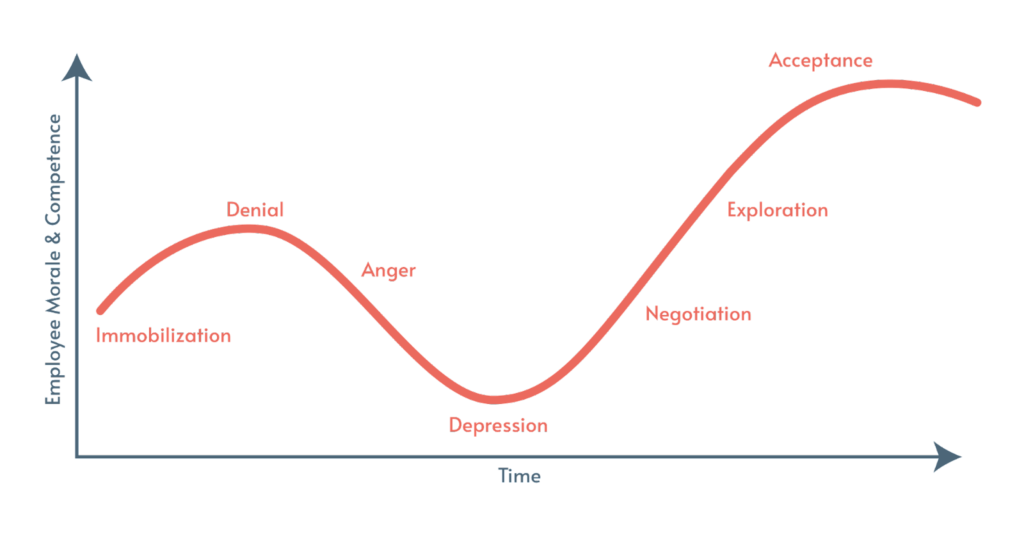When an organization begins the process of going through a transformation, employees will likely be emotionally tied to the current state. In the world of change management, “current state” refers to how things are today, or currently. This attachment is natural, but it’s what often makes transitions hard on individuals and creates a difficult job for leadership.
Transformations trigger an emotional response. When individuals are used to a system, they are most likely comfortable with the way things run within it. So, when change is on the horizon, it’s no surprise that team members and leaders may feel personal loss, concerns about what will be required of them, and apprehensions over their ability to meet new expectations. All of these emotions may roll over them before the transformation process even starts!
The most common reaction to transformations and transitional phases is the desire to keep things the same. This initial resistance inspires a lack of confidence that the transformation will be successful and solve real problems. Resistance and cynicism are natural and represent a reflection of the emotional phases that team members go through all the time.
As soon as members begin to feel these responses in response to transformation, it is the role of leaders to equip them to face these emotions with reassurance and understanding. Understanding our coworker’s emotional phases during these moments will make adapting to change in the workplace fluid and successful.
Emotional Phases and Organizational Transformations
Understanding the emotional phases that team members experience teaches leaders how to handle the situation. Being able to identify these phases is crucial because the individuals that make up our organization are the basis of our workplaces and businesses. Supporting them and keeping morale up should be one of our top priorities during any sort of transition period.

Based on the influential work of Dr. Kubler-Ross, above is our interpretation of the emotional phases individuals experience during transformations. And below are the recommended actions that leadership should take to guide them to acceptance and adoption.
| Phase | Symptoms | Recommended Actions |
| Immobilization | • Difficulty focusing on their job and responsibilities • Inability to understand updates regarding the transformation or the information doesn’t seem to sink in • Expression of feelings of disbelief and not knowing what to do next | • Share key facts about the transformation and the reasons for it • Say it more than once • Know what channels of communication work for your audience and utilize them • Communicate via a variety of methods and verbiage • Encourage them to get involved and give input • Learn more about how to communicate with team members here. |
| Denial | •Repetition of statements and thoughts including “They won’t do it,” “They will start but not finish,” or “We won’t really have to do it anyway” • Avoidance of opportunities to participate | • Describe what is not working well in the current situation • Split the transformation into smaller steps and focus on what to expect first • Help teams understand why each step is necessary and how they can support the throughout the process |
| Anger | • Inability to see anything positive about the transformation • Focus on negative perceptions, sharing these privately or publicly | • Shift perspective, don’t take this personally • Acknowledge the anger •Empathize with their reactions •Create an opportunity to speak openly about concerns and set expectations for engagement •Consider holding one-on-one meetings |
| Depression | • Disinterest regarding the transformation • Loss of enthusiasm for their job •Belief that the organization is unwilling to act upon their suggestions •Realization that their role and responsibilities are affected | • Encourage individuals to share their issues and concerns with their leadership • Inform them about resources that will be provided to support and help them through the process • Help them see their place and role in the future and the value they bring |
| Negotiation | • Negotiation of what is expected of them, the scope of the change, the solution or the timeline | • Make clear what parts of the desired state are negotiable • Be open to negotiation where possible • Negotiate only the parts of the desired state that are truly negotiable, don’t give false hope • Understand the implications of offering concessions to one group or person versus broadly |
| Exploration | • Investigation about the future state and how they fit • Participation and information sharing are improving • Expression of an increasingly positive attitude | • Acknowledge their progress • Emphasize how valuable their cooperation is • Encourage them to keep making steps forward • Focus on the positive points of the transformation • Develop opportunities for them to participate in resolving or understanding the less favorable elements of the change •Be sure to make support and learning programs known Learn more about ways to make individuals feel valued here. |
| Acceptance | • Participate in helping others understand and accept the transformation • Offer support and input • Engage in learning and communication opportunities • Demonstrate competency and supportive behaviors • Noticeably adapt to the change in the workplace | • Recognize their accomplishment and contribution to the success of the transformation • Understand what drove them to acceptance and share with others • Enlist them to help others reach acceptance • Share all progress toward success metrics |

Get more change management tips
All employees affected by change in an organization – including leaders and team members – are often faced with multiple transformations at the same time. Transitioning employees and the transformations themselves may seem lengthy, and this exhaustion also triggers complex emotional responses. Still wondering how to deal with change? At LaMarsh Global, we rely on data-informed strategies to help our clients manage continuous, complex organizational transformations. In addition to offering courses, we also provide direct support to any organization or business initiating a change. Visit our website or contact us directly to learn more.





